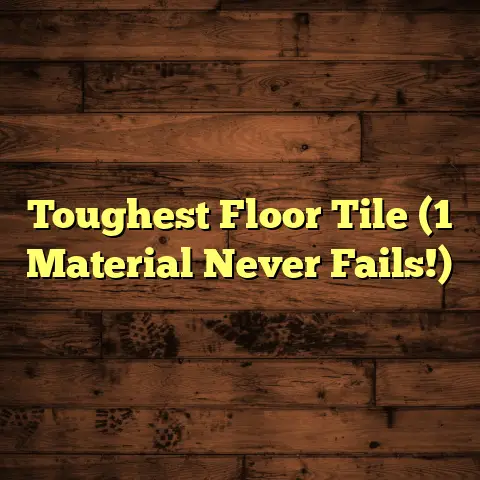Allen And Roth Vinyl Flooring Review? (Explained)
I can still remember the first time I installed vinyl flooring.
I was so excited that I practically tripped over the box while carrying it inside.
If only I’d known then what I know now about Allen and Roth vinyl flooring!
Spoiler alert: I didn’t trip over the final product, but I certainly learned a thing or two along the way.
Why Choose Allen and Roth Vinyl Flooring?
When it comes to flooring, I always prioritize durability, aesthetics, and maintenance.
Allen and Roth vinyl flooring checks all these boxes.
But let’s not get ahead of ourselves; let’s talk about my journey with this specific brand.
My First Encounter
I was working on a kitchen remodel for a lovely couple in a quaint neighborhood.
They were looking for something stylish yet practical.
After some research, I stumbled upon Allen and Roth vinyl flooring.
The couple was intrigued by its variety of designs, including wood and stone looks.
We decided to give it a shot!
Installation Process
The installation process is crucial, right?
The first thing to note is that Allen and Roth vinyl flooring is relatively easy to install compared to other options.
With the right tools—like a utility knife, a straight edge, and a good-quality underlayment—you can tackle this project in no time.
- Preparation: I always start by ensuring the subfloor is clean and dry.
This time, we had to remove some old tiles, which took longer than expected.
But hey, no pain, no gain! - Measuring: If you’ve ever heard the phrase “measure twice, cut once,” you know it’s true.
I used FloorTally to help with accurate measurements and cost estimates.
It pulls local material prices, so I was able to give the couple a detailed budget upfront. - Cutting and Laying: The vinyl planks are easy to cut, but I found that using a sharp blade made all the difference.
The locking mechanism on these planks is user-friendly, which meant less chance of making mistakes. - Final Touches: After laying the planks, I added quarter-round molding to give the room a polished look.
How Did It Turn Out?
Honestly, the transformation was impressive!
The couple loved the new look of their kitchen.
The wood-like design gave it a warm feel without the maintenance hassle of real wood.
As for durability?
They have three kids and a large dog; the flooring has held up like a champ!
A Few Challenges Along the Way
Every project has its ups and downs.
While the installation process was smooth overall, I faced some hiccups:
- Uneven Subfloor: We discovered that part of the subfloor was slightly uneven.
This isn’t uncommon in older homes.
We had to spend time leveling it out with self-leveling compound before moving forward. - Cutting Mistakes: I made a cutting error on one plank—talk about a facepalm moment!
Luckily, I had extra planks on hand from my initial order.
Maintenance Made Easy
One of the things I appreciate about Allen and Roth vinyl flooring is how easy it is to maintain.
A quick sweep and occasional mopping keep it looking new.
I advise clients to avoid harsh chemicals; a simple vinegar-water solution does wonders!
Cost Breakdown
Let’s talk numbers for a second because everyone loves a good deal!
- Material Cost: For this kitchen, we used 400 square feet of vinyl planks at around $3 per square foot.
That totaled about $1,200. - Installation Supplies: Including underlayment and adhesives, we spent another $200.
- Labor: I charged $300 for my time.
So in total, we were looking at about $1,700 for the entire project.
Not too shabby!
Comparing Options
I’ve worked with various flooring options, but what sets Allen and Roth apart?
Here’s how it stacks up against some other choices:
Laminate Flooring
- Pros: It’s affordable and comes in various designs.
- Cons: It can be prone to moisture damage and isn’t as durable as vinyl.
Hardwood Flooring
- Pros: Timeless appeal and can increase property value.
- Cons: Higher maintenance requirements and susceptibility to scratches.
Tile Flooring
- Pros: Extremely durable and water-resistant.
- Cons: Installation can be labor-intensive and costly.
For someone looking for an attractive yet practical flooring solution, Allen and Roth vinyl offers a great balance without breaking the bank.
Tips for Choosing Vinyl Flooring
Having gone through this experience multiple times, here are some tips I usually share with clients:
- Look for Warranty: A solid warranty can save you headaches down the road.
- Consider Your Space: Think about where you’ll install it—kitchens and bathrooms benefit from moisture-resistant options.
- Test Samples: Always bring home samples to see how they look in your lighting.
- Check Installation Methods: Some options require glue while others are click-lock; choose what suits your skill level.
My Ongoing Experience with Allen and Roth Vinyl Flooring
After that first project, I found myself recommending Allen and Roth vinyl flooring more often.
As I’ve worked on various residential projects since then, I’ve compiled some additional insights worth sharing.
Variety of Styles
One of the standout features of this brand is its variety.
Whether clients are looking for rustic oak or sleek modern designs, there’s something for everyone.
I remember helping a family choose a dark wood grain pattern for their living room—an excellent choice that made their space feel cozy yet elegant.
Installation Flexibility
The flexibility of installation options also makes Allen and Roth appealing.
For instance, I had a client who wanted to do a DIY project in their basement.
Using the click-lock system made it easy for them to handle the installation themselves with minimal guidance from me.
Real-Life Applications
I also had another project where we used Allen and Roth vinyl in a sunroom that had lots of windows and natural light streaming in.
The way the light bounced off the surface created an inviting atmosphere that impressed everyone who visited.
Addressing Common Concerns
While I’ve had mostly positive experiences with Allen and Roth vinyl flooring, some common concerns tend to pop up among clients.
Does It Scratch Easily?
This is a valid concern since pets and kids can be rough on floors.
In my experience, while no floor is completely scratch-proof, Allen and Roth has proven resilient against everyday wear and tear.
One client had two dogs that loved to run around—after two years, there were hardly any noticeable scratches!
Is It Waterproof?
Yes!
One of the main selling points of vinyl flooring is its waterproof nature.
This feature has been particularly beneficial in kitchens and bathrooms where spills are commonplace.
How Does It Handle Temperature Changes?
Vinyl can expand or contract slightly with temperature fluctuations; however, proper installation can mitigate these issues.
I always emphasize following guidelines regarding acclimation before installation—it makes a world of difference.
Comparing Costs with Other Materials
When considering different flooring options, cost is often at the forefront of decision-making.
Here’s how Allen and Roth stacks up against its competitors:
Hardwood vs. Vinyl
Hardwood flooring can range from $8 to $15 per square foot installed, without considering additional costs for maintenance over time.
In contrast, Allen and Roth vinyl averages around $3–$5 per square foot installed.
Tile vs. Vinyl
Tile installations can be similar in price to hardwood when factoring in labor costs due to their complexity.
Vinyl flooring offers a much more budget-friendly approach without sacrificing aesthetics.
Long-term Value
While initial costs are essential, consider long-term value as well.
Allen and Roth vinyl’s durability means fewer replacements over time compared to cheaper alternatives that may wear out quickly.
Maintenance Made Easy
One of my favorite features about Allen and Roth vinyl flooring is how easy it is to maintain:
- Regular Cleaning: A quick sweep or vacuum removes dirt and debris effectively.
- Mopping: Use a damp mop with mild soap or a vinegar-water solution for deeper cleaning.
- Avoid Harsh Chemicals: These can break down the protective layer on your floor over time.
I often remind clients that proper care will extend the life of their flooring significantly!
Practical Installation Tips
If you’re considering taking on an installation project yourself, here are some practical tips I’ve gathered over the years:
- Gather All Tools First: Before starting your project, ensure you have everything ready—there’s nothing worse than stopping mid-installation because you forgot something!
- Work in Sections: Breaking down your space into smaller sections makes it easier to manage.
- Use Spacers: When installing near walls or fixed objects, spacers help maintain necessary expansion gaps.
- Keep Planks Acclimated: Allow your planks to sit in the room where they’ll be installed for at least 48 hours before starting work; this helps reduce expansion issues later on.
The Role of FloorTally in My Projects
FloorTally has become an indispensable tool in my work as a flooring contractor.
During the kitchen remodel where we used Allen and Roth vinyl flooring, its features made my job much easier:
- Accurate Measurements: By inputting room dimensions into FloorTally, I received precise calculations on how many planks were needed without over-ordering.
- Cost Estimates: It provided real-time local pricing for materials based on my location, allowing me to create accurate budgets for clients quickly.
- Waste Management: FloorTally’s waste factor calculations helped me account for any mistakes or miscuts ahead of time.
With these features at my fingertips, I could focus on ensuring quality installation rather than worrying about logistics.
Final Thoughts
If you’re curious about whether Allen and Roth vinyl flooring is right for you, I’d say go for it!
It’s affordable, stylish, and holds up well against daily wear and tear.
As I wrap up this flooring adventure, I hope my experiences spark some insights for your upcoming projects!
Whether you’re tackling a kitchen remodel or simply upgrading your living room, there’s something magical about seeing flooring transform a space.
In my career as a contractor, I’ve seen many trends come and go—but quality remains timeless.
If you’re seeking practical advice grounded in real-world experience instead of flashy marketing claims, you’re in good hands here!
Happy flooring!





